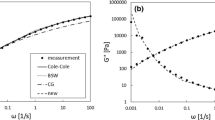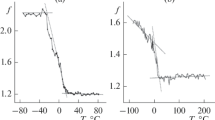Abstract
In this paper a recently introduced algorithm (Brabec and Schausberger, 1995) for the calculation of relaxation time spectra is compared with two standard methods, i.e., Weese's regularization, and Baumgaertel's and Winter's regression algorithm. A reasonable agreement between those three algorithms is found for the relaxation properties of mono-, polydisperse, bi-, and multimodal polystyrene samples. All three numerical methods reproduce the relaxation properties for long and medium times correctly, but they show some disagreement at short times because of sparse experimental data. The high numerical accuracy opens the possibility to test and improve the physical models which underlie the calculations. The good agreement of the different algorithms suggests that small inconsistencies to physical models are not due to a failure of the numerical methods, but due to an insufficiency of the generalized Maxwell model.
Similar content being viewed by others
References
Baumgaertel M, Winter HH (1989) Determination of discrete relaxation and retardation spectra from dynamic moduli. Rheol Acta 28:511–519
Baumgaertel M, Winter HH (1992) Interrelation between continuous and discrete relaxation time spectra. J Non-Newtonian Fluid Mech 44:15–36
Brabec CJ (1995) Calculation of relaxation time spectra with respect to the conversion to molar mass distributions. Thesis, J Kepler University Linz, Austria
Brabec CJ, Schausberger A (1995) An improved algorithm for calculating relaxation time spectra from material functions of polymers with monodisperse and bimodal molar mass distributions. Rheol Acta 34:397–405
Des Cloizeaux J (1990) Relaxation and viscosity anomaly of melts made of long entangled polymers. Time-dependent region. Macromolecules 23:4678–4687
Des Cloizeaux J (1992) Relaxation of entangled and partially entangled polymers in melts: time-dependent region. Macromolecules 25:835–841
Doi M, Edwards SF (1986) The theory of polymer dynamics. Clarendon Press, Oxford
Emri I, Tschoegl NW (1993) Generating line spectra from experimental responses. I. Relaxation modulus and creep compliance. Rheol Acta 32:311–321
Emri I, Tschoegl NW (1994) Generating line spectra from experimental responses. IV. Application to experimental data. Rheol Acta 33:60–70
Ferry JD (1980) Viscoelastic properties of polymers. John Wiley & Sons, New York
Friedrich C, Hofmann B (1983) Nichtkorrekte Aufgaben in der Rheometrie. Rheol Acta 22:425–434
Honerkamp J, Weese J (1989) Determination of the relaxation spectrum by regularization method. Macromolecules 22:4372–4377
Honerkamp J, Weese J (1993) A nonlinear regularization method for the calculation of relaxation time spectra. Rheol Acta 32:65
Honerkamp J, Weese J (1990) Tikhonovs regularization method for ill posed problems. Continuum Mech Thermo 2:17–30
Honerkamp J, Weese J, Elster JC (1991) Using regularization methods for the determination of relaxation and retardation spectra of polymeric liquids. Rheol Acta 30:161–174
Janeschitz-Kriegl H (1983) Polymer melt theology and flow birefringence. Springer, Berlin
Mead DW (1994) Numerical interconversion of linear viscoelastic material functions. J Rheol 38(6):1769–1795
Morozov VA (1984) Methods for solving incorectly posed problems. Springer, Berlin New York
Provencher SW (1982) CONTIN: A general purpose constrained regularization program for inverting noisy linear algebraic and integral equations. Comput Phys Commun 27:229–242
Schausberger A, Schindlauer G, Janeschitz-Kriegl H (1985) Linear elastico-viscous properties of molten standard polystyrenes. I. Presentation of complex moduli; role of short range structural parameters. Rheol Acta 24:220–227
Schausberger A (1986) A simple method of evaluating the complex moduli of polystyrene blends. Rheol Acta 25:596
Schindlauer G (1984) Zusammenhänge zwischen molekularen Parameters and linearem viskoelastischen Verhalten von Polymerschmelzen. Thesis, J Kepler University Linz, Austria
Tsenoglu C (1991) Molecular weight polydispersity effects on the viscoelasticity of entangled linear polymers. Macromolecules 24:1762–1767
Weese J (1992) Datenanalyse in der Rheologie mit Hilfe von Regularisierungsverfahren. Thesis, University Freiburg, Germany
Author information
Authors and Affiliations
Rights and permissions
About this article
Cite this article
Brabec, C.J., Rögl, H. & Schausberger, A. Investigation of relaxation properties of polymer melts by comparison of relaxation time spectra calculated with different algorithms. Rheol Acta 36, 667–676 (1997). https://doi.org/10.1007/BF00367363
Received:
Accepted:
Issue Date:
DOI: https://doi.org/10.1007/BF00367363




